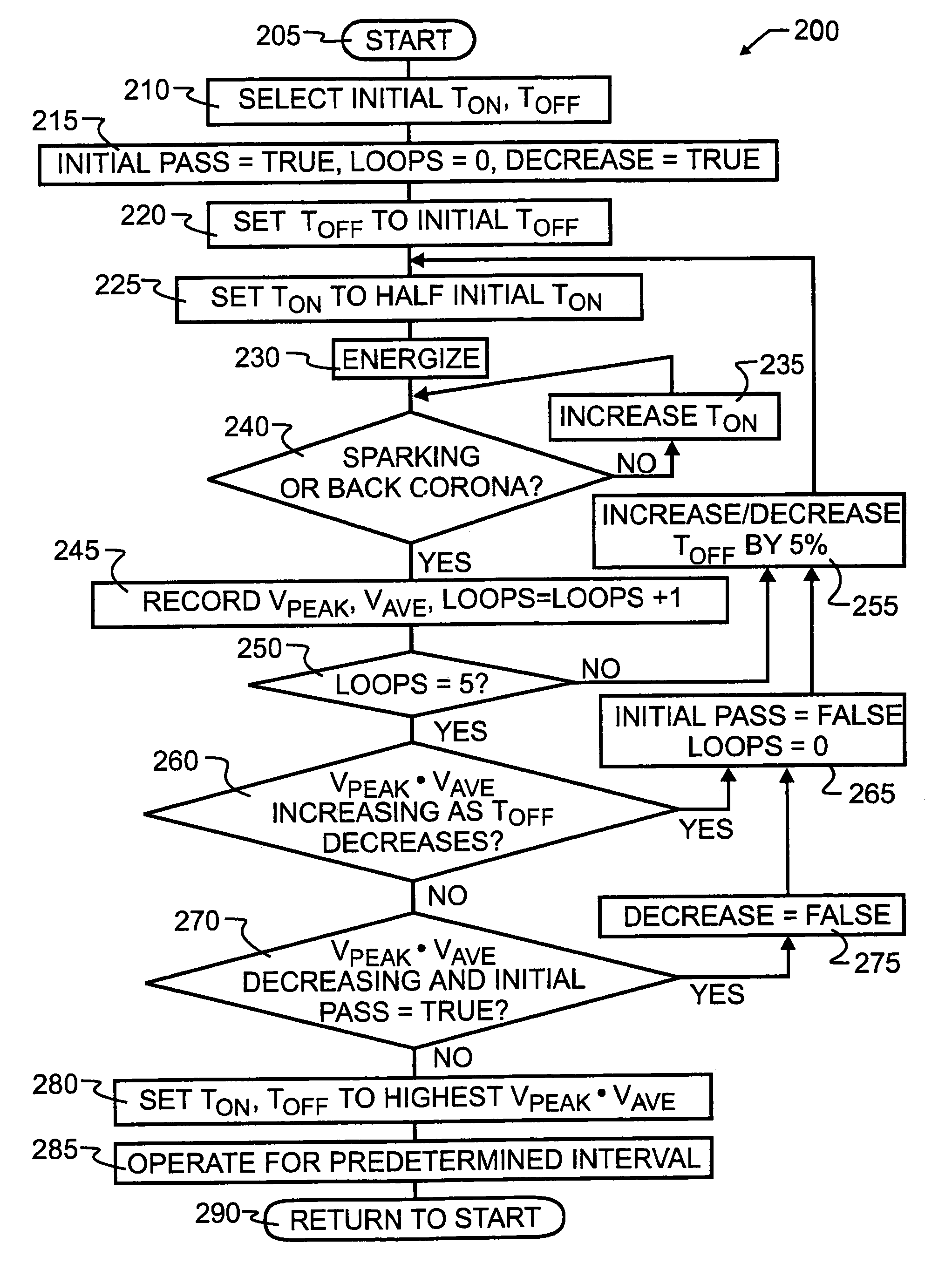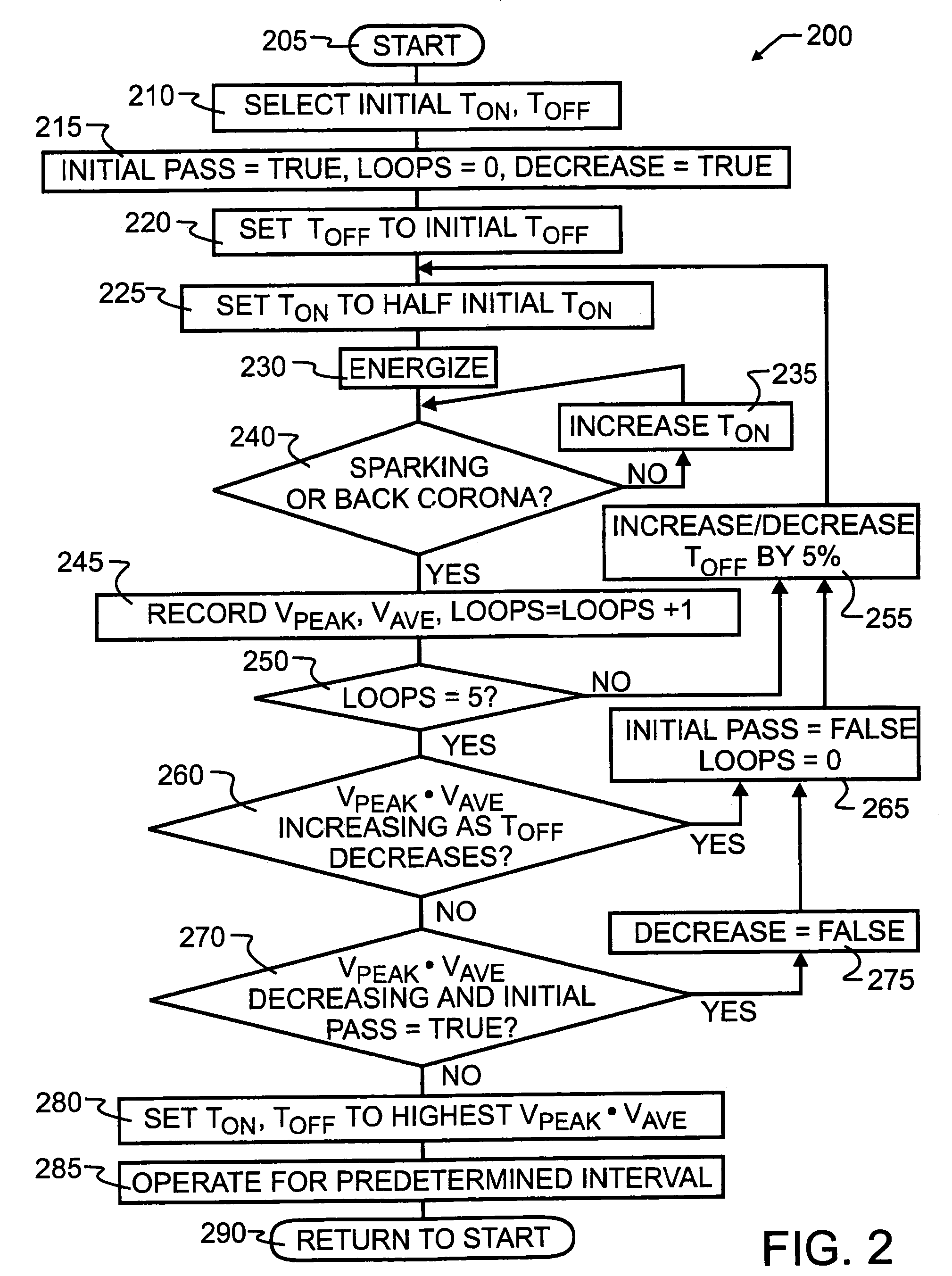ESP performance optimization control
a technology of electrostatic precipitator and optimization control, which is applied in the direction of electrical supply techniques, transportation and packaging, chemistry apparatus and processes, etc., can solve the problems of back-corona discharge or sparking, insufficient pure dc energization, and accumulation of precipitate layers, etc., to facilitate better collection of fly ash and improve the operational effectiveness of electrostatic precipitator systems.
- Summary
- Abstract
- Description
- Claims
- Application Information
AI Technical Summary
Benefits of technology
Problems solved by technology
Method used
Image
Examples
example 1
Intermittent Energization Self-Tuning Algorithm for Optimizing Peak Times Average in ESP Application
Steps to Achieving Self-Tuning:
[0047]Please note that the program may run each of the following steps multiple times (loop through numerous times) and use an average value (for any given step) to minimize the possibility of improper self-tuning due to sporadic operation of the esp.[0048]1. On initial turn-on of the high voltage, establish the voltage at which corona onset starts (Vco) and the voltage at which spark-over of the esp field occurs (Vsp). If no spark occurs, the voltage limit level becomes Vsp.[0049]2. The next step is to establish the value require for Toff. This is done by[0050]2.1 Ramping the voltage to K2*Vsp (where K2 is 80 to 95%) and letting the voltage decay until it reaches Vco. The value of Toff at this point becomes Toff—initial.[0051]2.2 The voltage is then turned back on again until K2*Vsp is reached; this time the voltage is allowed to decay for Toff=K3*Toff—...
example 2
Peak Times Average Algorithms
[0068]1. Determine corona onset voltage, sparking voltage, and the time (Ton initial) to go from corona onset to sparking voltage with full power on and the time (Toff initial) to drift from just below sparking voltage to corona onset voltage. Go to step 2.[0069]2. Pick initial Ton, which is slightly less than Ton initial (say 0.95 Ton initial). Go to step 3.[0070]3. Pick initial Toff (say Toff initial). Go to step 4.[0071]4. Starting with this Ton and Toff keeping reducing Toff until sparking occurs. Go to step 5.[0072]5. Increase Toff slightly (say Toff=1.05 Toff at spark). Go to step 6.[0073]6. Operate long enough with this Ton and Toff to determine Vpk and Vaverage and record these numbers and their product. Go to step 7.[0074]7. Decrease Ton slightly (say by 5%). Go to step 8.[0075]8. Repeat steps 3 through 7 until TON=0.05 TON INITIAL or until back corona occurs for the shortest TOFF. When TON=0.05 TON INITIAL or when back corona occurs for the sho...
PUM
 Login to View More
Login to View More Abstract
Description
Claims
Application Information
 Login to View More
Login to View More - R&D
- Intellectual Property
- Life Sciences
- Materials
- Tech Scout
- Unparalleled Data Quality
- Higher Quality Content
- 60% Fewer Hallucinations
Browse by: Latest US Patents, China's latest patents, Technical Efficacy Thesaurus, Application Domain, Technology Topic, Popular Technical Reports.
© 2025 PatSnap. All rights reserved.Legal|Privacy policy|Modern Slavery Act Transparency Statement|Sitemap|About US| Contact US: help@patsnap.com



